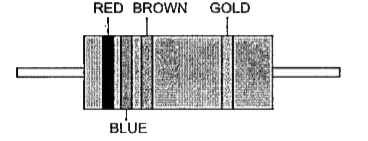Wire bound resistors are made by
winding the wires of an alloy viz, Cu,Al,Ag
winding the wires of an alloy viz, Si,Tu,Fe
winding the wires of an alloy viz, Ge,Au,Gr
winding the wires of an alloy viz,magnesium, constantan, nichrome
The correct Answer is:D
To answer the question "Wire bound resistors are made by," we can break down the solution into the following steps:
Step 1: Identify the Types of Resistors
Wire bound resistors are one of the two main types of resistors, the other being carbon resistors.
Hint: Remember that resistors can be categorized based on their construction materials.
Step 2: Understand Wire Bound Resistors
Wire bound resistors consist of a wire wound in the form of a coil. This design is crucial for their functionality.
Hint: Think about how the physical structure of a resistor affects its electrical properties.
Step 3: Determine the Materials Used
The wires used in wire bound resistors are typically made from specific alloys. Common alloys used include:
- Manganin
- Nichrome
- Constantan
Hint: Consider why certain materials are preferred for making resistors, especially in terms of their electrical properties.
Step 4: Explain the Choice of Alloys
Alloys are chosen for wire bound resistors because they have a resistivity that is largely insensitive to temperature changes. This means that the resistance remains stable even when the temperature fluctuates.
Hint: Reflect on the importance of temperature stability in electrical components.
Step 5: Discuss the Resistance Values
Wire bound resistors usually have resistance values that are either very small (in fractions of ohms) or a few hundred ohms. This range is suitable for various applications.
Hint: Think about how resistance values can affect the performance of electrical circuits.
Final Answer
Wire bound resistors are made from alloys such as manganin, nichrome, and constantan. These materials are selected due to their temperature stability and suitable resistivity, allowing for consistent performance across a range of temperatures.
Wire bound resistors are one of the two main types of resistors, the other being carbon resistors.
Wire bound resistors consist of a wire wound in the form of a coil. This design is crucial for their functionality.
The wires used in wire bound resistors are typically made from specific alloys. Common alloys used include:
- Manganin
- Nichrome
- Constantan
Alloys are chosen for wire bound resistors because they have a resistivity that is largely insensitive to temperature changes. This means that the resistance remains stable even when the temperature fluctuates.
Wire bound resistors usually have resistance values that are either very small (in fractions of ohms) or a few hundred ohms. This range is suitable for various applications.
Wire bound resistors are made from alloys such as manganin, nichrome, and constantan. These materials are selected due to their temperature stability and suitable resistivity, allowing for consistent performance across a range of temperatures.
Topper's Solved these Questions
- CURRENT ELECTRICITYBOOK - NCERT FINGERTPS ENGLISHCHAPTER - CURRENT ELECTRICITYEXERCISE - TEMPERATURE DEPENDENCE OF RESISTIVITY
7 Videos
- CURRENT ELECTRICITYBOOK - NCERT FINGERTPS ENGLISHCHAPTER - CURRENT ELECTRICITYEXERCISE - ELECTRICAL ENERGY, POWER
8 Videos
- CURRENT ELECTRICITYBOOK - NCERT FINGERTPS ENGLISHCHAPTER - CURRENT ELECTRICITYEXERCISE - LIMITATIONS OF OHM S LAW
4 Videos
- COMMUNITCATION SYSTEMSBOOK - NCERT FINGERTPS ENGLISHCHAPTER - COMMUNITCATION SYSTEMSEXERCISE - Assertion And Reason
30 Videos
- DUAL NATURE OF RADIATION AND MATTER BOOK - NCERT FINGERTPS ENGLISHCHAPTER - DUAL NATURE OF RADIATION AND MATTER EXERCISE - Assertion And Reason
15 Videos
Similar Questions
Knowledge Check
A carbon resistor has coloured bands as shown in figure below. The resistance of the resistor is :
 A26Ω±10%B26Ω±5%C260Ω±5%D260Ω±10%
A26Ω±10%B26Ω±5%C260Ω±5%D260Ω±10%
A resistor circuit is constructed such that 12 resistor are arranged to form a cube as shown in fig. Each resistor has a resistance of 2Ω. The potential difference of 30V is applied across two of the opposing points as shown

If we replace resistor between A and B and resistors between G and H by wires of zero resistance, then the points having the same potential are
i. D,E,C,F ,ii. A,B ,iii. G,H
View SolutionWhat is electrical resistivity ? In a series electrical circuit comprising a resistor made up of a matallic wire, the ammeter reads 5A. The reading of the ammeter decreases to half when the length of the wire is doubled. Why ?
View SolutionAnswer the following :
(a) Why are the connections between the resistors in a meter bridge made of thick copper strips?
(b) Why is it generally preferred to obtain the balance point in the middle of the meter bridge wire?
View SolutionGive Reason
Conducting wires are made of metals.
View SolutionMembrane bound organelles are absent in
View SolutionMembrane bound organelles are absent in
View SolutionMembrane bound organelles are absent in
View Solution
